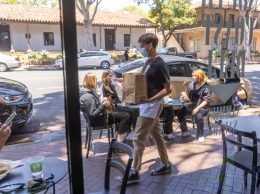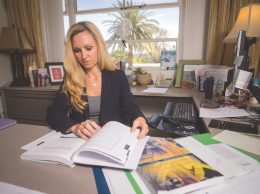The pain from the COVID-19 pandemic will be here for a while, but we can learn from it.
That was a theme of a UC Santa Barbara economic webinar examining the effects of COVID-19 on Santa Barbara County and what that means going forward.
The May 7 webinar featured four local experts on subjects ranging from health care to the economy and the disconnect between business and government.
First to speak was Lynn Fitzgibbons, chair of the Infectious Diseases Division at Cottage Health, who also spoke during the first UCSB webinar on April 16. She gave an update as to where the county stood in terms of preparation and number of confirmed coronavirus cases.
“Even though we have had deaths, we have a larger and larger number every day of people who have had (COVID-19) and recovered,” Fitzgibbons said.
Unfortunately, the tools the nation has to measure the pandemic are flawed. The primary way of testing for COVID-19, PCR testing, may miss between 25-40 percent of cases, depending on where and when someone is tested, she said. Someone may have coronavirus, be tested by drawing samples from the upper respiratory tract, and have the test give a false negative because the test missed the virus being shed in the throat.
Additionally, having already caught COVID-19 doesn’t guarantee a person is “safe” from getting it again. Unlike chicken pox, measles or other more common viruses, there isn’t proven immunity, and some countries have reported cases of people who once had COVID-19 coming down with it again.
“We do not yet have evidence that a positive (COVID-19) antibody is the same thing as protection,” Fitzgibbons said. “We do not know if they are immune or protected if they see that virus again.”
She also took the time to re-emphasize that no treatments have been proven to be effective against coronavirus, but some promising treatments are being investigated, including using plasma from people who have already beat the virus to help people still fighting it. It’s already being explored in Santa Barbara County — eight Cottage Health patients had received the treatment when she spoke.
Peter Rupert, a UCSB economics professor and director of the Economic Forecast Project, compared the pandemic to previous ones, including the “Hong Kong Flu” which raged from 1968 to 1970. He noted that Woodstock, which was held in August 1969, was in the middle of a pandemic.
“Who knows how many lives could have been saved if there had been some kind of mitigation,” Rupert said.
Even with some modern precedents for pandemics, though, Rupert has never seen anything like the current situation. Within a month and a half, 33 million people in the United States applied for unemployment insurance.
“We’ve never seen the world shut down like this before,” Rupert said.
And now that the world is shut down, it’ll be hard to get it going again.
“We closed the economy with a sledgehammer, but that’s not how we’re going to reopen,” Rupert said. “We’re going to reopen with a scalpel.”
Rupert proposed suggestions which let the majority of people come back, but still offer protections for those who can’t or shouldn’t be exposed. Instead of paying everyone monthly checks, Rupert proposed paying people over 65 to not go to work.
“We want to be very careful about who we want to be out there,” Rupert said. “We need lots of creative ideas.”
He also pointed to a statistic from the Hamilton Project, an economic policy initiative think tank. Its survey stated more than 40 percent of mothers with young children said they have experienced food insecurity since the disaster began, with the number expected to rise as the economy remained shut down.
The economy won’t truly recover until people feel safe to go back to their previous behaviors, though, and that might be a while off.
Joanne Funari, executive vice president and Chief Operating Officer at American Riviera Bank, spoke about how the bank is supporting local businesses through the crisis.
At the time Funari spoke, the bank had funded 577 Payroll Protection Program loans, making it the No. 1 SBA lender in San Luis Obispo and Santa Barbara counties. Many community banks, like American Riviera, have processed more than twice the amount they normally do in a year, and they did it in the course of a few weeks.
Even with all of the help that has been given, though, Funari expects there to be a third round of funding or a second CARES Act, especially as some businesses may not be allowed to reopen for several more weeks and even months, depending on the level of outbreak severity in the area. These businesses include personal services like hair and nail salons, gyms and fitness studios, but also entertainment venues like movie theaters, museums, nightclubs and concert venues.
The crisis has also laid bare some of the existing weaknesses in preparations. Kristen Miller, CEO of the Goleta Chamber of Commerce, spoke about wishing everyone had done a little more to prepare for a possible disaster like this — in comparison to other disasters like wildfires and mud slides, which the area knows how to handle.
“We are a bit lost,” Miller said. “We’re doing the best we can.”
Communities are starting to figure out if there are ways they can celebrate holidays like the Fourth of July without meeting in person. When the panic has passed, though, Miller wants everyone to use the recovery period to address issues the crisis highlighted, including a general disconnect between business communities and their local governments.
“We are smart, compassionate, innovative people,” Miller said, “and we’ve found out more than ever that we thrive in our tribes.”
• Contact Amber Hair at ahair@pacbiztimes.com.






 Print
Print Email
Email

















